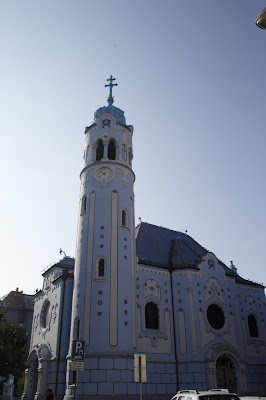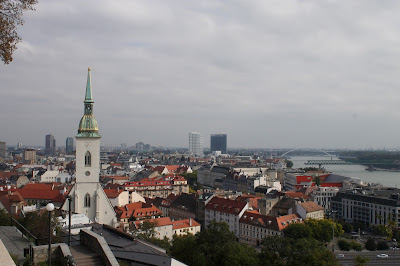Things to catch up on . . .
Some short answers: awesome Singstar parties, making smores, giving our best guesses while playing the 1981 version of Trivial Pursuit (one of the only games we have), watching two seasons of American Horror Story, getting a Halloween care package from my parents, endless/terrifying/hilarious games of Slapjack, dying my hair, joining a tandem bike gang, and many other amazing moments.
A long answer: we got back from a trip to Slovakia and Budapest last week! Just like Copenhagen, it was incredible. So many cool things to see, and this time, we were learning more about the history, which made it even more interesting. In the US, we don't spend much time learning about European history, so a lot of this stuff was completely new for me.
Our group left early Monday, and after a bus ride to Gothenburg, a plane to Budapest, and a train ride, we were in Bratislava. And again, just like Copenhagen, we arrived on a cold, rainy, dreary night, and we were all pretty ready for bed. In spite of our tiredness, we roamed around the city for a bit with the help of our amazing friend/fellow student/Slovak-in-residence tour guide, Zuzana! She goes to university in Bratislava, but is spending the semester abroad at Mullsjö, so we were really lucky to have had her on this trip.
In the morning, we went on a guided tour around the city. This was our first look at everything in the daytime, and we were finally able to see all the cool, old buildings, full of character and history. The architecture was mostly faded pastels, with little decorative aspects here and there, on the windows or the roof. Simple, but elegantly old. After some research (thanks, Wikipedia!), I learned that some buildings in the area we stayed in (Old Town) date back to the 14th or 15th century. There was definitely a cool architectural mix of eras in Bratislava, it was like you could see the progressing years through the buildings. You could see elements from the classical 14th-15th century, the Baroque period, then eventually a more communistic style took over (bleak, plain high rise buildings maybe with images of people working on them), and finally, the remodeling or the grafiti. So many places were under construction when we visited, it really seemed like a city undergoing some massive changes. However, a ton of the buildings were tagged wih grafiti, and it was a little sad to so many old, beautiful buildings with spray paint on them. (Warning: I believe that grafiti can be art, but it doesn't mean that all grafiti is good art. We actually saw some really awesome grafiti on our train ride back to Budapest, but when it looks so obviously like gangsters trying to rep their gang, I'm not that into it, though there are expections. End rant.)
Being in Bratislava's Old Town, we were in the location of some hugely important historical events for Slovakia (formerly Czechoslovakia). We were in the the center where Napoleon's army tried to attack, the square where the Soviet Union invaded in 1968, and Hviezdoslav Square where there was a massive candle demonstration protesting communist rule in 1988, which is thought to have instigated the end of communism in Czechoslovakia. The funny thing about Napoleon is that he's become a silly tourist attraction now, and people can take pictures with his statue right in the place where he tried to invade.
 |
| Famous photo from day of Soviet invasion, showing Emil Gallo standing up to Soviet tanks. Taken by Ladislav Bielik |
 |
| Famous "Blue Church"- Church of St. Elisabeth |
 |
| Inside of the church |
 |
| Bratislava Castle |
 |
| An amazing view of the city from the castle |
I didn't get any good pictures of the Budapest train station, but is definitely worth mentioning. Old architecture and beautiful skylights in such a massive building, it was just jaw dropping. I constantly felt this way walking through Budapest. Landmark after landmark, the style of the city was just amazing. You could tell there was a crazy amount of history behind everything, and you were never too far away from something interesting. One of our professors pointed out to us the style of art nouveau, which showed itself in many buildings throughout the city. It's characterized by organic ornamentation and flourishes, detailing many aspects of the buildings. Like Bratislava, different eras could also be seen, like the gothic period, and even some almost classical oriental or Eastern influences. Walking around on first day, we were able to check out lots of examples of the different architecture. We went to the edge of the city where we could see across the Danube River, and I was completely floored by the view. Budapest automatically became my favorite place. Right in front of us were two bridges, between them was a huge beige castle with green roofs and a tall, green dome. Scattered around were fancy buildings and old church steeples. To the far left on a hill was a statue of a woman holding up a leaf, with her dress dramatically blown in the wind (we didn't visit her, but it's called the Liberty Statue). I was overwhelmed with everything, I could hardly believe I was there in that moment! Sort of like a dream.
 |
| Buda Castle- my pictures don't do this city justice at all! |
As we kept moving along, we saw the Parliament building, which was equally awesome (EVERYTHING about Budapest was awesome, just to clarify). A huge, incredibly detailed white and rusty red monster, covered in pointy spires, statues, ornaments, and all sort of little intricacies. The building is so large that it's hard to get a good photo of it when you're standing right in front of it, but from across the river, you can see it really well.
 |
| Hungarian Parliament Building |
 |
| Parliament from across the Danube |
Our next stop of the day was St. Stefan's Basilica, which was probably my favorite part of the entire trip. Though not as enormous as Parliament, it looked much heavier. Almost like it was a strong, sturdy place worthy to worship in. The outside was beige and green, with statues and decorative elements, but the inside was something special. Embellishments everywhere, with golds and reds, and biblical paintings across every surface. There was a service going on with a priest chanting, kneeling in front of the small audience of church members. Again, it felt like a dream. I've never seen anything so beautiful in my life!
The next day, we had a busy schedule across the river. In the morning, we paid a visit to the Swedish embassy, where we talked with the Swedish ambassador. He was a really nice, talkative guy, who was open to all our questions, especially those about the refugee crisis. Hungary was previously open to taking in some refugees until leadership began to strongly oppose it. Since then, Hungary has been more of a place for refugees to pass through, rather than to stay. Sweden, on the other hand, is taking in record numbers of refugees. It was interesting to discuss how different countries have responded to this crisis. (If you'd like to learn how to help those in need, click here, or make a direct donation to the UN Refugee Agency.)
The rest of the day was all sightseeing . . .
 |
| View from Fisherman's Bastion |
 |
| Buda Castle- up close! Much bigger and more elaborate than my picture shows |
 |
| Budapest Market Hall- huge building filled with tons of food and souvenir shops |
Our last day in Budapest, we visited the House of Terror, a museum detailing the history of Hungary under the Nazi and Communist regimes. The building itself is historic in that it housed both the Nazi headquarters and the Communist secret police at different times. I knew basically nothing about the effects Nazism and Communism had on Hungary, so it was really heartbreaking to see how such tragic things played out there. A summary of what happened: When Germany occupied Hungary in WWII, facist, Nazi supporters called the Arrow Cross Party took over the Hungarian government. At the end of the war, the country was overtaken by the Soviet army during the Seige of Budapest and the Arrow Cross Party dissolved. After the war, the Soviets slowly began introducing a Communist government in Hungary, even though Hungarians voted for a different party in a post-war election. Using the AVH (Soviet secret police), enemies of the government were executed, imprisoned, or deported. Many were sent to labor camps, where they died from starvation, overwork, and poor working conditions. It was really sad to read that some returning victims of the Holocaust were then sent to these camps. I'm not exactly sure how the Hungarians overthrew the Communist government, but there was a revolution, and it wasn't until 1989 that Hungary adopted a new political system.
It was fitting that our next stop was the Dohány Street synagogue in Budapest's Jewish district. It was a really beautiful building with an amazing history. Before the war broke out in Hungary, two older ladies took religious artifacts from the synagogue, like menorahs, Torah scrolls, and even large stained glass windows, and hid them. Everything was eventually returned safe and sound. During the war, the synagogue was part of the Budapest ghetto, where many people died. Around 2,000 are buried in the cemetery courtyard, even though there is apparently a historic rule about cemeteries being a certain distance away from a synagogue. Though Hungary gave over its Jewish population to the Nazis, I was really surprised that the building wasn't completely destroyed by anyone earlier. The only severe damage it suffered was from bombing raids by the Arrow Cross Party early in the war, and again during the Siege of Budapest at the end of the war. In Germany for example, Jewish homes and businesses were destroyed during Kristallnacht, but nothing similar happened in Hungary (thankfully!). The synagogue was restored in the 90s, and it's an absolutely amazing piece of architecture. Just look at it!
 |
We left Budapest early Friday morning, and after being absolutely exhausted from the trip home, we were so happy to come back to friends who had thrown us a welcome home party! Complete with chips, ice cream, and cake. :) It was such a great surprise, and it was nice to see that they missed us as much as we missed them. I seriously love these beautiful weirdos so much. I couldn't be more thankful to have met such awesome people here.
Thank you for enduring these incredibly long blog posts. Hej då!
 |
| Left to right: Sabrina, Luke, Mariko, Isak, Alex, Marco, and Saki. Missing Zuzana and Pedro- but they celebrated with us later :) |





